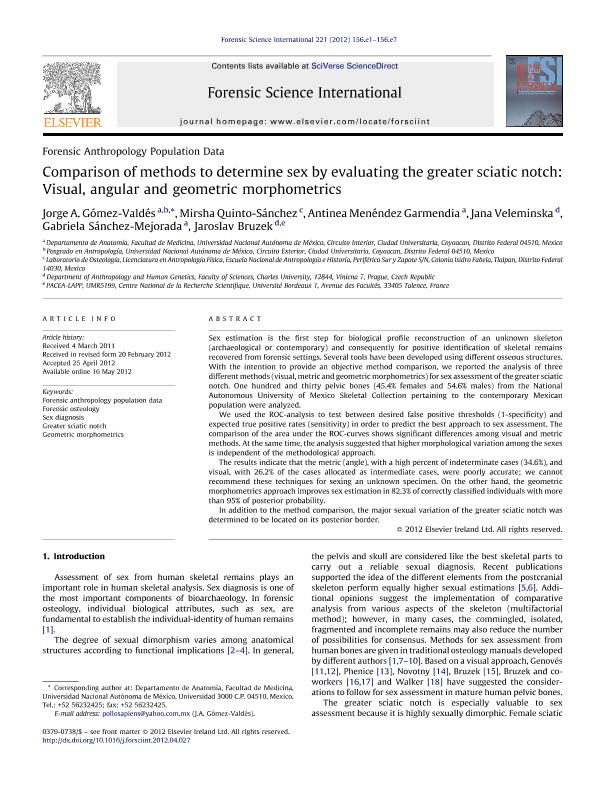Mostrar el registro sencillo del ítem
dc.contributor.author
Gómez Valdés, Jorge A.
dc.contributor.author
Quinto Sanchez, Mirsha Emmanuel

dc.contributor.author
Menéndez Garmendia, Antinea
dc.contributor.author
Veleminska, Jana
dc.contributor.author
Sánchez Mejorada, Gabriela
dc.contributor.author
Bruzek, Jaroslav
dc.date.available
2018-10-03T18:00:46Z
dc.date.issued
2012-09
dc.identifier.citation
Gómez Valdés, Jorge A.; Quinto Sanchez, Mirsha Emmanuel; Menéndez Garmendia, Antinea; Veleminska, Jana; Sánchez Mejorada, Gabriela; et al.; Comparison of methods to determine sex by evaluating the greater sciatic notch: Visual, angular and geometric morphometrics; Elsevier Ireland; Forensic Science International; 221; 1-3; 9-2012; 1-7
dc.identifier.issn
0379-0738
dc.identifier.uri
http://hdl.handle.net/11336/61540
dc.description.abstract
Sex estimation is the first step for biological profile reconstruction of an unknown skeleton (archaeological or contemporary) and consequently for positive identification of skeletal remains recovered from forensic settings. Several tools have been developed using different osseous structures. With the intention to provide an objective method comparison, we reported the analysis of three different methods (visual, metric and geometric morphometrics) for sex assessment of the greater sciatic notch. One hundred and thirty pelvic bones (45.4% females and 54.6% males) from the National Autonomous University of Mexico Skeletal Collection pertaining to the contemporary Mexican population were analyzed.We used the ROC-analysis to test between desired false positive thresholds (1-specificity) and expected true positive rates (sensitivity) in order to predict the best approach to sex assessment. The comparison of the area under the ROC-curves shows significant differences among visual and metric methods. At the same time, the analysis suggested that higher morphological variation among the sexes is independent of the methodological approach.The results indicate that the metric (angle), with a high percent of indeterminate cases (34.6%), and visual, with 26.2% of the cases allocated as intermediate cases, were poorly accurate; we cannot recommend these techniques for sexing an unknown specimen. On the other hand, the geometric morphometrics approach improves sex estimation in 82.3% of correctly classified individuals with more than 95% of posterior probability.In addition to the method comparison, the major sexual variation of the greater sciatic notch was determined to be located on its posterior border.
dc.format
application/pdf
dc.language.iso
eng
dc.publisher
Elsevier Ireland

dc.rights
info:eu-repo/semantics/openAccess
dc.rights.uri
https://creativecommons.org/licenses/by-nc-sa/2.5/ar/
dc.subject
Forensic Anthropology Population Data
dc.subject
Forensic Osteology
dc.subject
Geometric Morphometrics
dc.subject
Greater Sciatic Notch
dc.subject
Sex Diagnosis
dc.subject.classification
Otras Ciencias Biológicas

dc.subject.classification
Ciencias Biológicas

dc.subject.classification
CIENCIAS NATURALES Y EXACTAS

dc.title
Comparison of methods to determine sex by evaluating the greater sciatic notch: Visual, angular and geometric morphometrics
dc.type
info:eu-repo/semantics/article
dc.type
info:ar-repo/semantics/artículo
dc.type
info:eu-repo/semantics/publishedVersion
dc.date.updated
2018-07-23T17:21:57Z
dc.journal.volume
221
dc.journal.number
1-3
dc.journal.pagination
1-7
dc.journal.pais
Irlanda

dc.description.fil
Fil: Gómez Valdés, Jorge A.. Universidad Nacional Autónoma de México; México
dc.description.fil
Fil: Quinto Sanchez, Mirsha Emmanuel. Escuela Nacional de Antropología e Historia; México. Consejo Nacional de Investigaciones Científicas y Técnicas. Centro Nacional Patagónico; Argentina
dc.description.fil
Fil: Menéndez Garmendia, Antinea. Universidad Nacional Autónoma de México; México
dc.description.fil
Fil: Veleminska, Jana. Charles University; República Checa
dc.description.fil
Fil: Sánchez Mejorada, Gabriela. Universidad Nacional Autónoma de México; México
dc.description.fil
Fil: Bruzek, Jaroslav. Universidad Nacional Autónoma de México; México. Universite de Bordeaux; Francia
dc.journal.title
Forensic Science International

dc.relation.alternativeid
info:eu-repo/semantics/altIdentifier/doi/http://dx.doi.org/10.1016/j.forsciint.2012.04.027
dc.relation.alternativeid
info:eu-repo/semantics/altIdentifier/url/https://www.sciencedirect.com/science/article/pii/S0379073812001983
Archivos asociados
